Energy Efficiency Enhancement of Inductively Coupled Plasma Torch: Computational Study
Abstract
:1. Introduction
2. Torch Geometry and Operating Conditions
3. Model Description
3.1. Basic Model Assumptions
- (i).
- The plasma system is modeled by a two-dimensional axisymmetric configuration, and the outer inductor is represented by a series of parallel conductive rings infinitely thin. The significant voltage that appears in windings, acting as an axial electric field inducing a dielectric barrier discharge type, can be avoided when placing the torch vertically rather than horizontally.
- (ii).
- The flow of working fluid is at a steady state, compressible, with a small Mach number (Ma < 0.3).
- (iii).
- During torch operation, we consider moderate mass flow rates with a low Reynolds number (Re 500) and laminar flow.
- (iv).
- The plasma is in a state of local thermodynamic equilibrium (LTE).
- (v).
- Optically thin plasma, so radiation reabsorption is negligible.
- (vi).
- Plasma displacement current can be ignored as it is relatively small compared to conductive current.
- (vii).
- The heat generated by viscous dissipation is neglected in the energy equation.
- (viii).
- Ohmic heating is responsible for volumetric power input.
3.2. Governing Equations and Boundary Conditions
3.3. Thermodynamic and Transport Properties
3.4. Calculation Conditions
4. Results and Discussion
4.1. Comparison of Numerical and Experimental Plasma Characteristics
4.2. Analysis of Temperature and Velocity Flow Distributions in ICP Torch
4.3. Variation of Plasma Parameters
4.3.1. Effect of RF Power
4.3.2. Influence of Sheath Gas Flow Rate
4.3.3. Nobel Sheath Gas Composition Effect on the Plasma Torch
4.3.4. Effect of Swirl Flow
4.4. Effect of Geometry Torch
4.4.1. Variation of Coil Spacing
4.4.2. Effect of Turns Coil Number Variation
5. Conclusions
Author Contributions
Funding
Institutional Review Board Statement
Informed Consent Statement
Data Availability Statement
Acknowledgments
Conflicts of Interest
References
- Givelet, L.; Truffier-Boutry, D.; Noël, L.; Damlencourt, J.F.; Jitaru, P.; Guérin, T. Optimization and application of an analytical approach for the characterization of TiO2 nanoparticles in food additives and pharmaceuticals by single particle inductively coupled plasma-mass spectrometry. Talanta 2021, 224, 121873. [Google Scholar] [CrossRef] [PubMed]
- Mozhayeva, D.; Engelhard, C. A critical review of single particle inductively coupled plasma mass spectrometry—A step towards an ideal method for nanomaterial characterization. J. Anal. At. Spectrom. 2020, 35, 1740–1783. [Google Scholar] [CrossRef] [Green Version]
- Isaguirre, A.C.; Moyano, M.F.; Gil, R.A.; Moglia, M.M. A Novel and Simple Method for Elements Determination in Aerobiological Samples by Inductively Coupled Plasma Mass Spectrometry (ICP-MS) Analysis. Water Air Soil. Poll. 2020, 231, 1–9. [Google Scholar] [CrossRef]
- Flores, K.; Turley, R.S.; Valdes, C.; Ye, Y.; Cantu, J.A.; Hernandez-Viezcas, J.G.; Parsons, J.G.; Gardea-Torresdey, J.L. Environmental applications and recent innovations in single particle inductively coupled plasma mass spectrometry (SP-ICP-MS). Appl. Spectrosc. Rev. 2021, 56, 1–26. [Google Scholar] [CrossRef]
- Tanvir, E.M.; Komarova, T.; Comino, E.; Sumner, R.; Whitfield, K.M.; Shaw, P.N. Effects of storage conditions on the stability and distribution of clinical trace elements in whole blood and plasma: Application of ICP-MS. J. Trace Elem. Med. Bio. 2021, 68, 126804. [Google Scholar] [CrossRef]
- Brouwers, E.E.M.; Tibben, M.; Rosing, H.; Schellens, J.H.M.; Beijnen, J.H. The application of inductively coupled plasma mass spectrometry in clinical pharmacological oncology research. Mass. Spectrom. Rev. 2008, 27, 67–100. [Google Scholar] [CrossRef]
- Tan, X.; Liu, M.; He, K. Study of Long-Term Determination Accuracy for REEs in Geological Samples by Inductively Coupled Plasma Quadrupole Mass Spectrometry. Molecules 2021, 26, 290. [Google Scholar] [CrossRef]
- Sun, H.; Yao, Y.; Loomis, R.A.; Buhro, W.E. Methods for the ICP-OES Analysis of Semiconductor Materials Calynn Morrison. Chem. Mater. 2020, 32, 1760–1768. [Google Scholar] [CrossRef]
- Lee, J.J. Application of inductively coupled plasma to CVD and PVD. Surf Coat. Tech. 2005, 200, 31–34. [Google Scholar] [CrossRef]
- Qin, X.Z.; Yang, G.; Cai, F.P.; Jiang, B.; Chen, H.; Tan, C.H. Recovery and reuse of spent LiFePO4 batteries. J. New Mater. Electrochem. Syst. 2019, 22, 119–124. [Google Scholar] [CrossRef]
- Gabbar, H.A.; Darda, S.A.; Damideh, V.; Hassen, I.; Aboughaly, M.; Lisi, D. Comparative study of atmospheric pressure DC, RF, and microwave thermal plasma torches for waste to energy applications. Sustain. Energy Technol. Assessments. 2021, 47, 101447. [Google Scholar] [CrossRef]
- Isaac, H. Study of Radio Frequency Inductively Coupled Thermal Plasma Torch (RF ICPT) for Radioactive Waste Treatment: Thermoplastics—Polyethylene and Polyvinyl Chloride (PVC). Master’s Thesis, University of Ontario Institute of Technology, Oshawa, ON, Canada, 2021. [Google Scholar]
- Zhu, B.; Alavi, S.; Cheng, C.; Sun, H.; Zhao, H.; Kim, K.S.; Mostaghimi, J.; Zou, Y. Fast and High-Throughput Synthesis of Medium- and High-Entropy Alloys Using Radio Frequency Inductively Coupled Plasma. Adv. Eng. Mater. 2020, 23, 2001116. [Google Scholar] [CrossRef]
- Aldakheel, R.K.; Gondal, M.A.; Almessiere, M.A.; Rehman, S.; Nasr, M.M.; Alsalem, Z.; Khan, F.A. Spectrochemical analysis using LIBS and ICP-OES techniques of herbal medicine (Tinnevelly Senna leaves) and its anti-cancerous/antibacterial applications. Arab. J. Chem. 2021, 14, 103451. [Google Scholar] [CrossRef]
- Wang, D.; Hao, Z.; Zhu, X.; Zhou, F.; Shu, Y.; He, J. spheroidization of lithium niobate powder by radiofrequency inductively coupled plasma. Ceram Int. 2022, 48, 12126–12131. [Google Scholar] [CrossRef]
- Racka-Szmidt, K.; Stonio, B.; Zelazko, J.; Filipiak, M.; Sochacki, M. A Review: Inductively Coupled Plasma Reactive Ion Etching of Silicon Carbide. Materials 2022, 15, 123. [Google Scholar] [CrossRef] [PubMed]
- Mirek, P.; Alavi, S.; Mostaghimi, J. A Novel Radio Frequency Inductively Coupled Plasma Torch for Material Processing. Plasma Chem. Plasma Process. 2021, 41, 1547–1566. [Google Scholar] [CrossRef]
- Samal, S.; Tyc, O.; Cizek, J.; Klecka, J.; Lukác, F.; Molnárová, O.; De Prado, E.; Weiss, Z.; Kopecek, J.; Heller, L. Fabrication of Thermal Plasma Sprayed NiTi Coatings Possessing Functional Properties. Coatings 2021, 11, 610. [Google Scholar] [CrossRef]
- Zhang, X.; Hayashida, R.; Tanaka, M.; Watanabe, T. Synthesis of carbon-coated silicon nanoparticles by induction thermal plasma for lithium ion battery. Powder Technol. 2020, 371, 26–36. [Google Scholar] [CrossRef]
- Thompson, M.; Walsh, J.N. Handbook of Inductively Coupled Plasma Spectrometry, 2nd ed.; Springer Science & Business Media: New York, NY, USA, 1989; p. 316. [Google Scholar] [CrossRef]
- Boulos, M.I. The role of transport phenomena and modelling in the development of thermal plasma technology. Plasma Chem. Plasma Process. 2016, 36, 3–28. [Google Scholar] [CrossRef]
- Yu, N.; Yang, Y.; Jourdain, R.; Gourma, M.; Bennett, A.; Fang, F. Design and optimization of plasma jet nozzles based on computational fluid dynamics. Int. J. Adv. Manuf. Tech. 2020, 108, 2559–2568. [Google Scholar] [CrossRef]
- Yu, N.; Jourdain, R.; Gourma, M.; Xu, F.; Bennett, A.; Fang, F. Power Dissipation of an Inductively Coupled Plasma Torch under E Mode Dominated Regime. Micromachines 2021, 12, 834. [Google Scholar] [CrossRef]
- Boulos, M.I. The inductively coupled R.F. (radiofrequency) plasma. Pure Appl. Chem. 1985, 57, 1321–1352. [Google Scholar] [CrossRef]
- Punjabi, S.B.; Das, T.K.; Joshi, N.K.; Mangalvedekar, H.A.; Lande, B.K.; Das, A.K. The effect of various coil parameters on ICP torch simulation. J. Phys. Conf. Ser. 2010, 208, 012048. [Google Scholar] [CrossRef] [Green Version]
- Lindner, H.; Bogaerts, A. Multi-element model for the simulation of inductively coupled plasmas: Effects of Helium addition to the central gas stream. Spectrochim. Acta Part B At. Spectrosc. 2011, 66, 421–431. [Google Scholar] [CrossRef]
- Merkhouf, A.; Boulo, M.I. Distributed energy analysis for an integrated radio frequency induction plasma system. J. Phys. D Appl. Phys. 2000, 33, 1581–1587. Available online: http://iopscience.iop.org/0022-3727/33/13/304 (accessed on 4 June 2022). [CrossRef]
- Merkhouf, A.; Boulos, M.I. Integrated model for the radio frequency induction plasma torch and power supply system. Plasma Sources Sci. Technol. 1998, 7, 599–606. [Google Scholar] [CrossRef]
- Xue, S.; Proulx, P.; Boulos, M.I. Extended-field electromagnetic model for inductively coupled plasma. J. Phys. D Appl. Phys. 2001, 34, 1897–1906. [Google Scholar] [CrossRef]
- Cai, M.; Montaser, A.; Mostaghimi, J. Computer simulation of atmospheric pressure Helium inductively coupled plasma discharges. Spectrochim. Acta Part B At. Spectrosc. 1993, 48, 789–807. [Google Scholar] [CrossRef]
- Bernardi, D.; Colombo, V.; Ghedini, E.; Mentrelli, A. Comparison of different techniques for the FLUENT based treatment of the electromagnetic field in inductively coupled plasma torches. Eur. Phys. J. D 2003, 27, 55–72. [Google Scholar] [CrossRef]
- Fouladgar, J.; Chentouf, A. The calculation of the impedance of an induction plasma installation by a hybrid finite-element boundary-element method. IEEE Trans. Magn. 1993, 29, 2479. [Google Scholar] [CrossRef]
- Ye, R.; Proulx, P.; Boulos, M.I. Turbulence phenomena in the radio frequency induction plasma torch. Int. J. Heat Mass Tran. 1999, 42, 1585–1595. [Google Scholar] [CrossRef]
- COMSOL AB. COMSOL Multiphysics V5.4. Multiphysics Particle Tracing Module User’s Guide; COMSOL AB: Stockholm, Sweden. 2019. Available online: https://doc.comsol.com/5.3/doc/com.comsol.help.particle/ParticleTracingModuleUsersGuide.pdf (accessed on 8 November 2021).
- Bolot, R.; Coddet, C.; Schreuders, C.; Leparoux, M.; Siegmann, S. Modelling of an Inductively Coupled Plasma for the Synthesis of Nanoparticles. Journal of Thermal Spray Technology. J. Spray Techn. 2007, 16, 690–697. [Google Scholar] [CrossRef]
- Shigeta, M.; Sato, T.; Nishiyama, H. computational simulation of the particle laden RF inductively coupled plasma with seeded potassium. Int. J. Heat Mass Tran. 2004, 47, 707–716. [Google Scholar] [CrossRef]
- Mostaghimi, J.; Proulx, P.; Boulos, M.I. Parametric study of flow and temperature fields in an inductively coupled RF Plasma Torch. J. Plasma Chem. Plasma 1985, 4, 199–217. [Google Scholar] [CrossRef]
- Yang, J.G.; Yoon, N.S.; Kim, B.C.; Choi, J.H.; Lee, G.S.; Hwang, S.M. Power Absorption Characteristics of an Inductively Coupled Plasma Discharge. IEEE Trans. Plasma Sci. 1999, 27, 676–681. [Google Scholar] [CrossRef]
- Eizaguirre, S.; Gehring, T.; Denk, F.; Simon, C.; Kling, R. Argon ICP plasma torch at atmospheric pressure driven by a SiC based resonant converter operating in MHz range. In Proceedings of the International Exhibition and Conference for Power Electronics, Intelligent Motion, Renewable Energy and Energy Management (PCIM Europe Digital Days 2020), Nuremburg, Germany, 7–8 July 2020. [Google Scholar]
- Punjabi, S.B.; Barve, D.N.; Joshi, N.K.; Das, A.K.; Kothari, D.C.; Ganguli, A.A.; Sahasrabhude, S.N.; Joshi, J.B. Computational Fluid Dynamics (CFD) Simulations and Experimental Measurements in an Inductively- Coupled Plasma Generator Operating at Atmospheric Pressure: Performance Analysis and Parametric Study. Processes 2019, 7, 133. [Google Scholar] [CrossRef] [Green Version]
- Turkoz, E. Numerical Model for Axisymmetric Inductively Coupled Plasma (ICP) in Radiofrequency (RF) Ion Thrusters. Master’s Thesis, Graduate Program in Mechanical Engineering, Bogazici University, Istambul, Turkey, 7 May 2014. [Google Scholar]
- Kim, J.; Mostaghimi, J.; Iravani, R. Performance Analysis of a Radio-Frequency Induction Plasma Generator Using Nonlinear State-Space Approach. IEEE Trans. Plasma Sci. 1997, 25, 1023–1028. [Google Scholar] [CrossRef]
- Chentouf, A.; Fouladgar, J.; Develey, G. A simplified method for calculation of the impedance of an induction plasma. IEEE Trans. Magn. 1995, 31, 2100–2103. [Google Scholar] [CrossRef]
- Grover, F.W. Inductance calculations. Circuits Systems. 1946, 4, 95–163. [Google Scholar]
- Boulos, M.I.; Fauchais, P.; Pfender, E. Thermal Plasmas: Fundamentals and Applications, 1st ed.; Springer: New York, NY, USA, 1994; p. 452. [Google Scholar] [CrossRef]
- Dodt, D.H. Determination of the Electron Energy Distribution Function of a Low Temperature Plasma from Optical Emission Spectroscopy. PhD’s Thesis, Ernst-Moritz-Arndt-Universität Greifswald, Griefswald, Germany, 5 January 2009. [Google Scholar]
- Bernardi, D.; Colombo, V.; Ghedini, E.; Mentrelli, A. Three-dimensional Effects in the Modelling of ICPTs—Part I: Fluid Dynamics and Electromagnetics. Eur. Phys. J. D 2003, 25, 271–277. [Google Scholar] [CrossRef]
- COMSOL AB. COMSOL Multiphysics® v. 5.4; COMSOL AB: Stockholm, Sweden. 2015. Available online: https://www.comsol.com/ (accessed on 8 November 2021).
- Xie, Z.; Pavlidis, D.; Salinas, P.; Pain, C.; Matar, O. A control volume finite element method for three-dimensional three-phase flows. Int. J. Numer. Meth. Fluids. 2020, 92, 765–784. [Google Scholar] [CrossRef] [Green Version]
- Punjabi, S.B.; Sahasrabuddhe, S.N.; Ghorui, S.; Joshi, N.K.; Das, A.K.; Kothari, D.C.; Ganguli, A.A.; Joshi, J.B. Flow and temperature patterns in the coil region of Inductively Coupled Plasma Reactor: Experimental measurements and CFD simulations. AIChE J. 2014, 60, 3647–3664. [Google Scholar] [CrossRef]
- Lesinski, J.; Gagne, R.; Boulos, M.I. Gas and Particle Velocity Measurements in an Induction Plasma. In Technical Report; University of Sherbrooke: Sherbrooke, QC, Canada, 1981; pp. 527–533. [Google Scholar]
- Punjabi, S.B.; Joshi, N.K.; Mangalvedekar, H.A.; Lande, B.K.; Das, A.K.; Kothari, D.C. A comprehensive study of different gases in inductively coupled plasma torch operating at one atmosphere. Phys. Plasmas. 2012, 19, 012108. [Google Scholar] [CrossRef]
- Mostaghimi, J.; Boulos, M.I. Two-Dimensional Electromagnetic Field Effects in Induction Plasma Modelling. Plasma Chem. Plasma Process. 1989, 9, 25–44. [Google Scholar] [CrossRef]
- Shigeta, M. Time-dependent 3D simulation of an Argon RF inductively coupled thermal plasma. Plasma Sources Sci. Technol. 2012, 21, 055029. [Google Scholar] [CrossRef]
- Khalili, A.; Sadat Kiai, S.M.; Mahdian, H. Collisional cooling in an inductively coupled plasma torch. J. Phys. Astron. JOPA 2016, 4, 23–28. [Google Scholar] [CrossRef]
- Alavi, S.; Mostaghimi, J. A Novel ICP Torch with Conical Geometry. Plasma Chem. Plasma Process. 2019, 39, 359–376. [Google Scholar] [CrossRef]
- Grobler, N.J.M.; Bissett, H.; Puts, G.J.; Crouse, P.L. Finite-element analysis of the effect of sheath-gas composition in an inductively coupled plasma. In Proceedings of the Conference of the South African Advanced Materials Initiative (CoSAAMI-2018), Vanderbijlpark, South Africa, 23–26 October 2018. [Google Scholar] [CrossRef]
- Carcione, J.M. A spectral numerical method for electromagnetic diffusion. Geophysics 2006, 71, I1–I9. [Google Scholar] [CrossRef]
- Nishiyamay, H.; Muro, Y.; Kamiyama, S. The control of gas temperature and velocity fields of a RF induction thermal plasma by injecting secondary gas. J. Phys. D Appl. Phys. 1996, 29, 2634–2643. [Google Scholar] [CrossRef]
- Abeele, D.V.; Degrez, G. Similarity analysis for the high-pressure inductively coupled plasma source. Plasma Sources Sci. Technol. 2004, 13, 680–690. [Google Scholar] [CrossRef]
- Deng, J.; Zhang, J.; Zhang, Q.; Xu, S. Effects of induction coil parameters of plasma torch on the distribution of temperature and flow fields. Alex. Eng. J. 2021, 60, 501–510. [Google Scholar] [CrossRef]
- Elaissi, S.; Ben Gouider Trabelsi, A.; Alkallas, F.H.; Alrebdi, T.A.; Charrada, K. Modeling of Advanced Silicon Nanomaterial Synthesis Approach: From Reactive Thermal Plasma Jet to Nanosized Particles. Nanomaterials 2022, 12, 1763. [Google Scholar] [CrossRef] [PubMed]
- Xue, S.; Proulx, P.; Boulos, M.I. Effect of the coil angle in an inductively coupled plasma torch: A novel two-dimensional model. Plasma Chem. Plasma Process. 2003, 23, 245–263. [Google Scholar] [CrossRef]
- Kulacki, F.A.; Acharya, S.; Chudnovsky, Y.; Cotta, R.M.; Devireddy, R.; Dhir, V.K.; Pinar Mengüç, M.; Mostaghimi, J.; Vafai, K. Handbook of Thermal Science and Engineering, 1st ed.; Springer International Publishing AG: Cham, Switzerlan, 2018; p. 3043. [Google Scholar] [CrossRef]
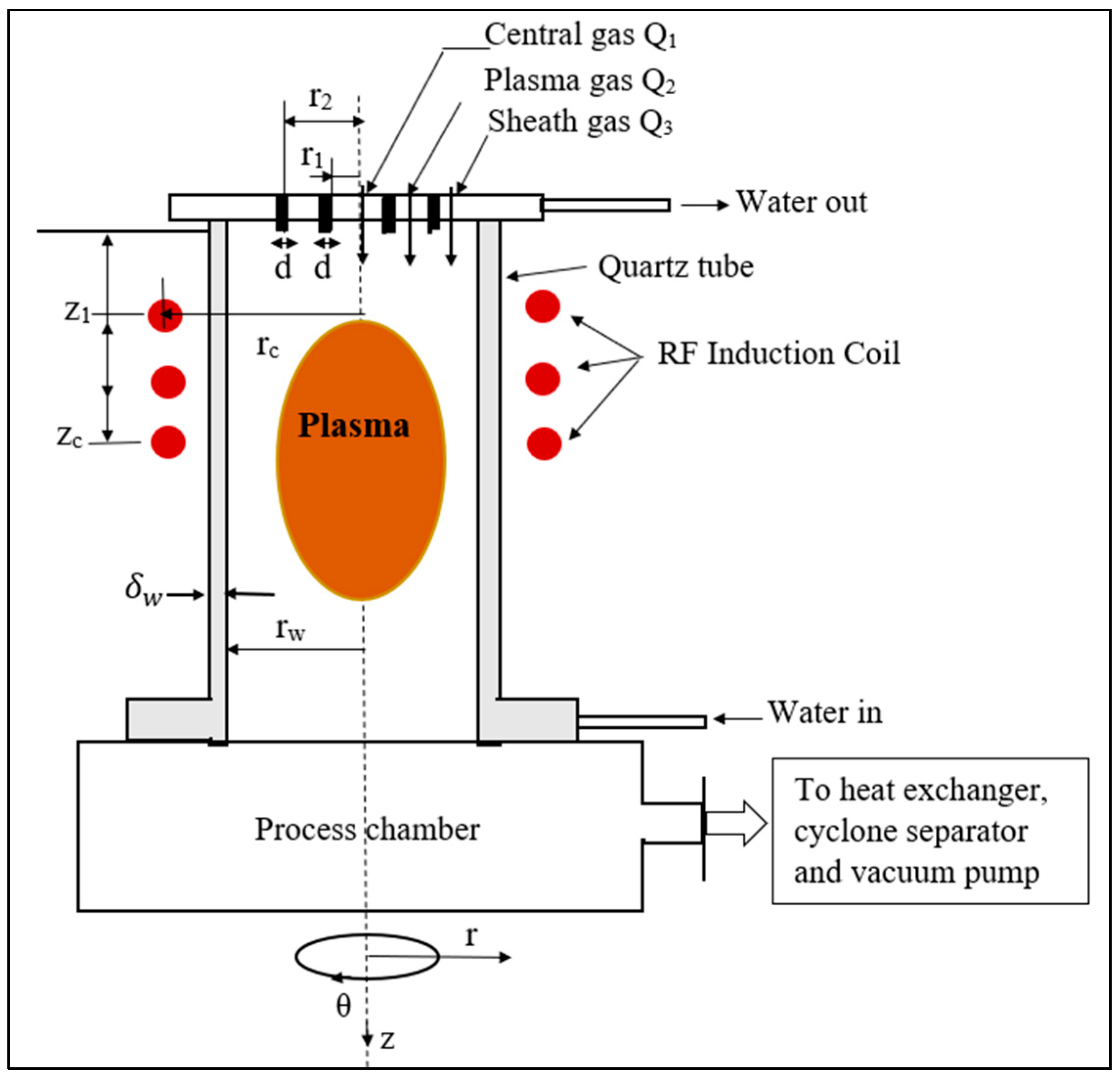
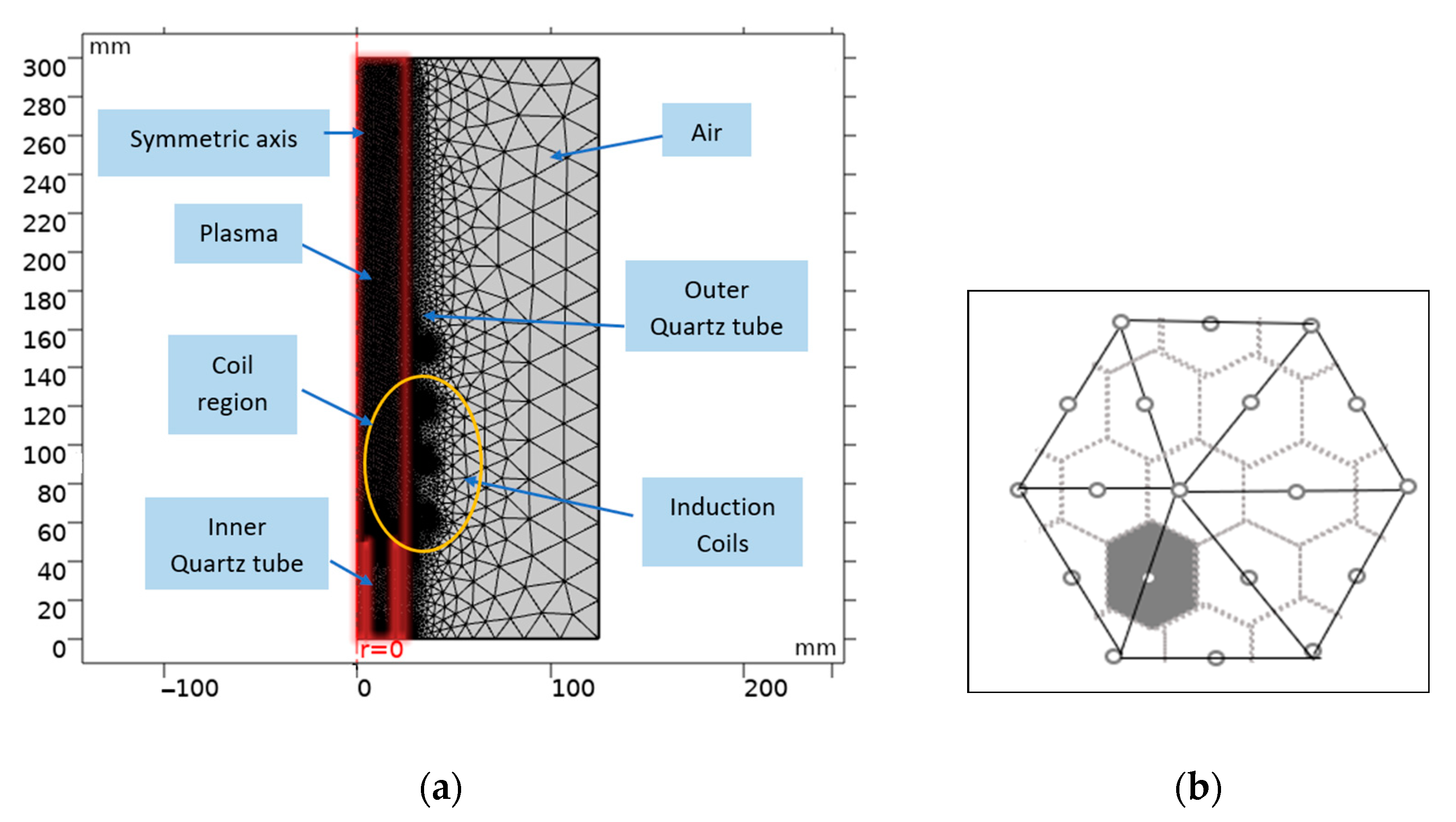
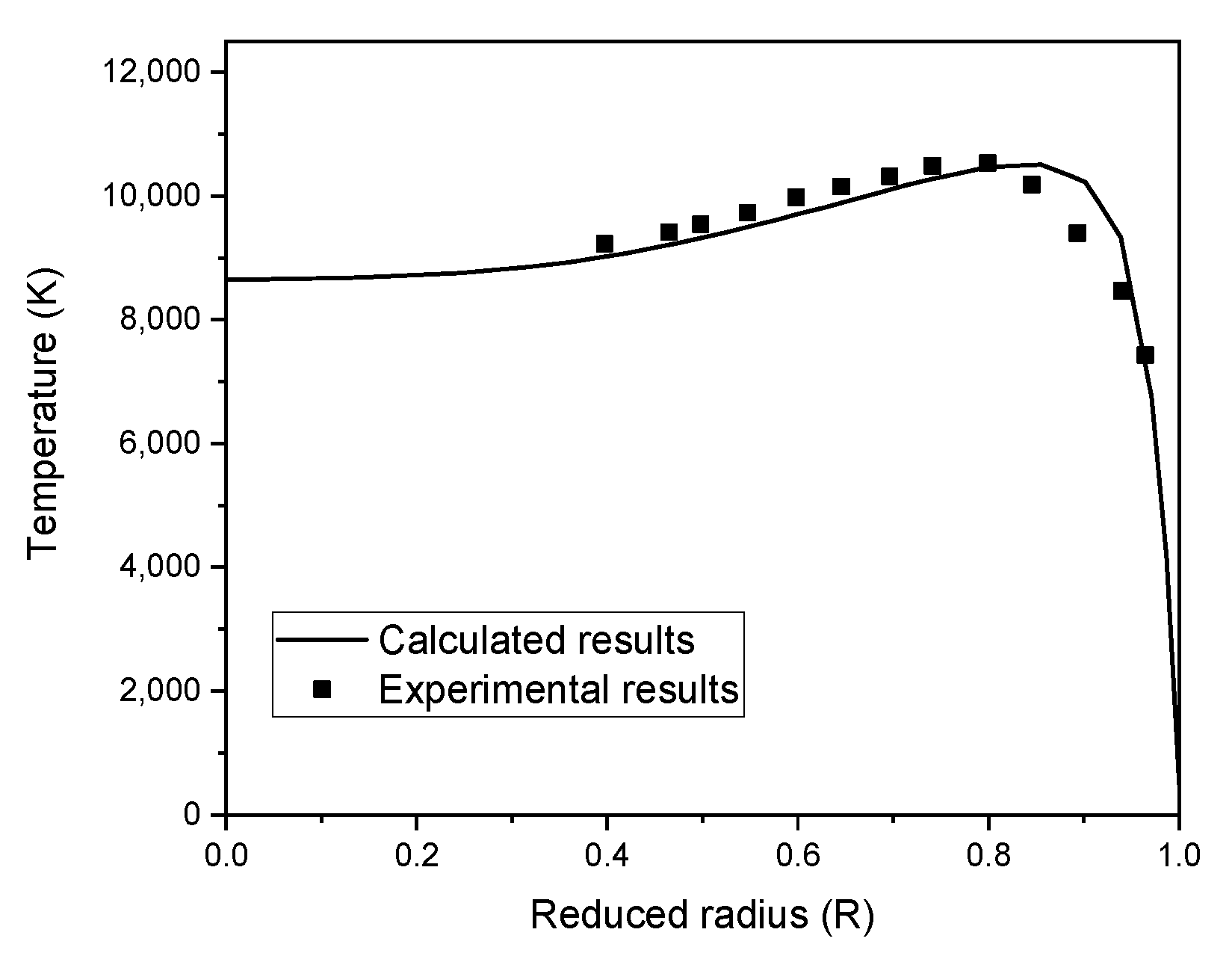
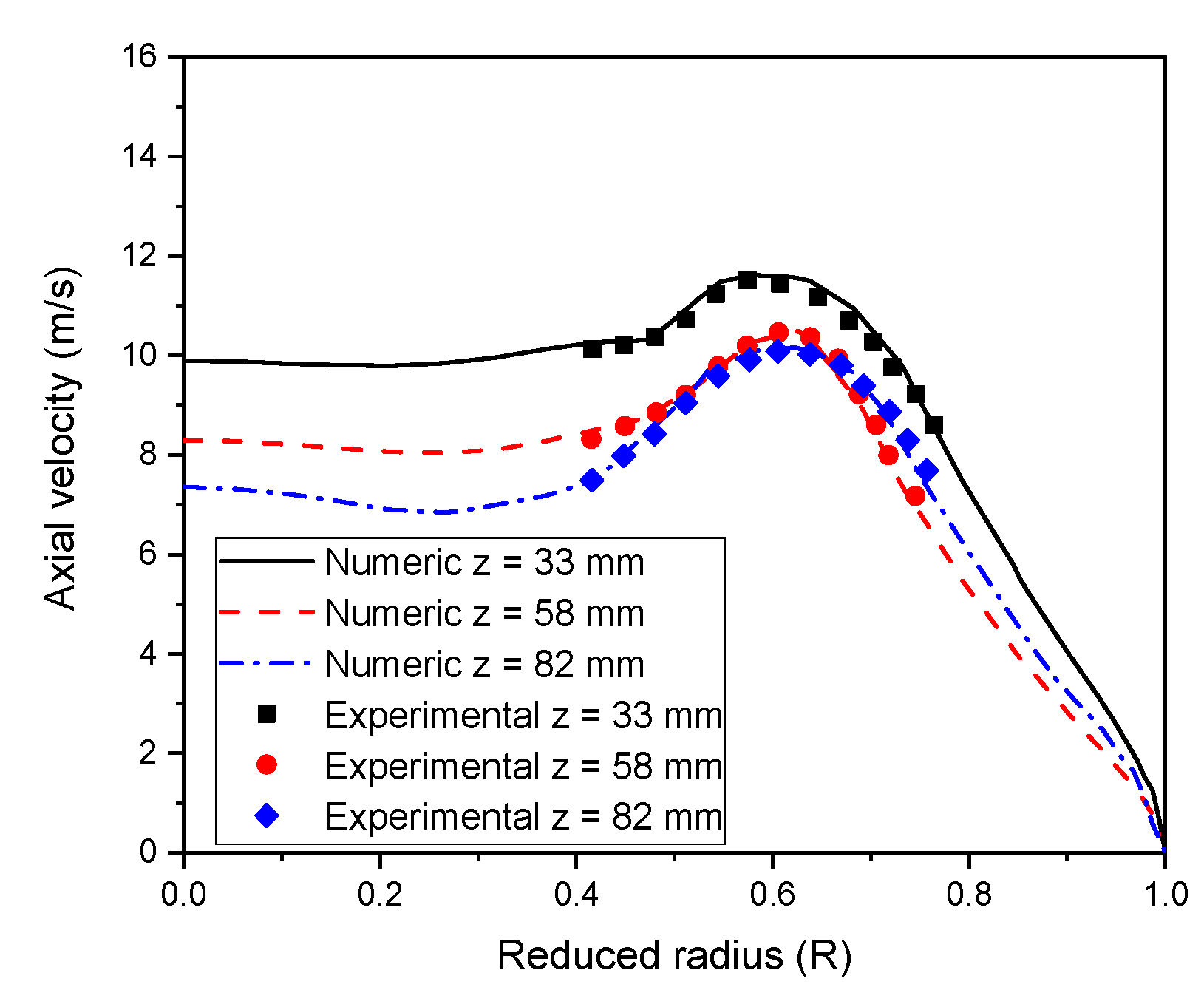
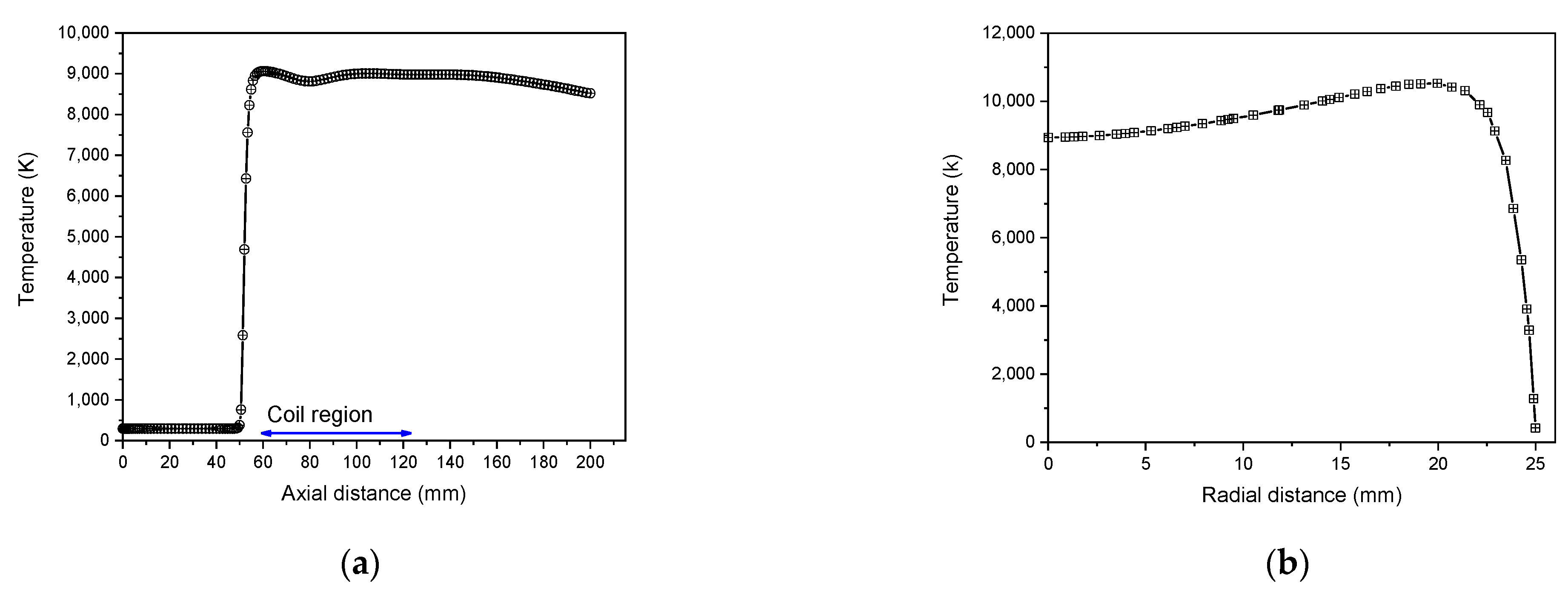
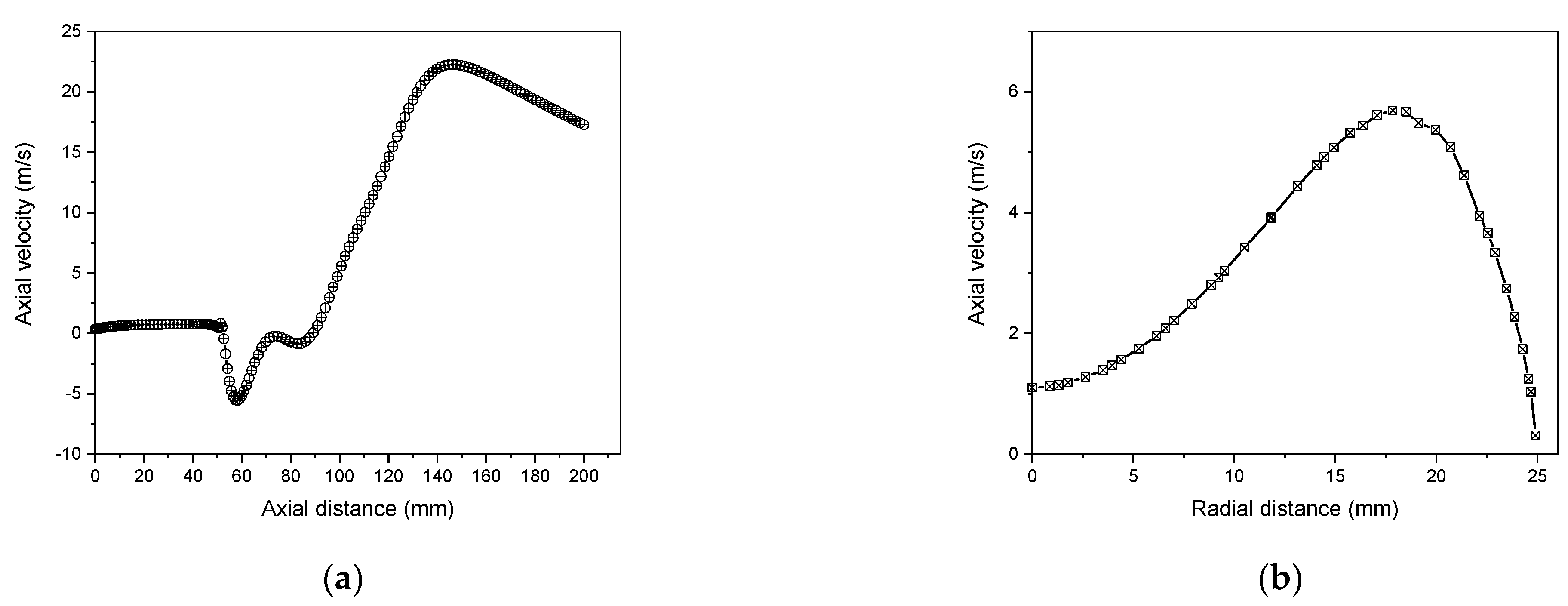
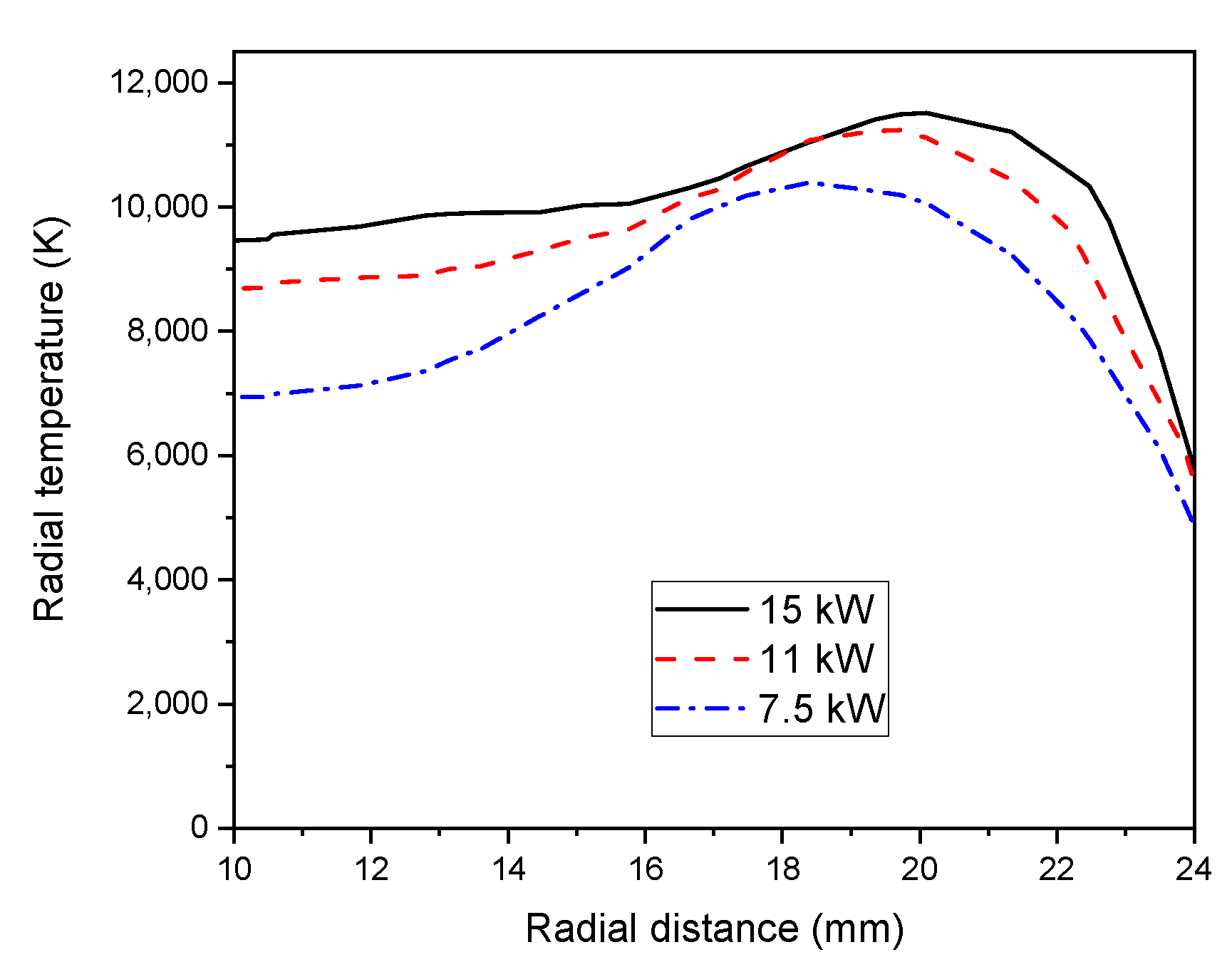
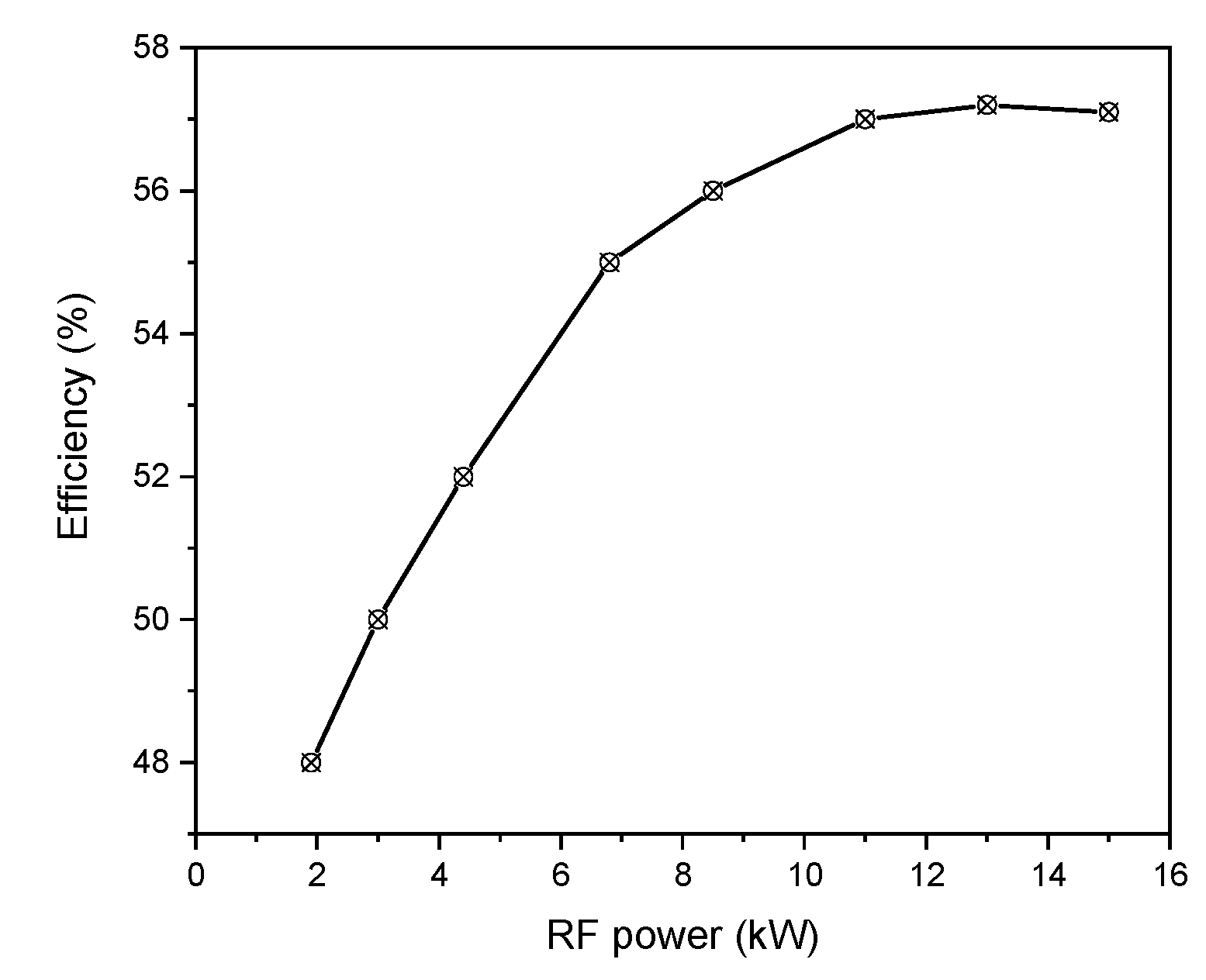
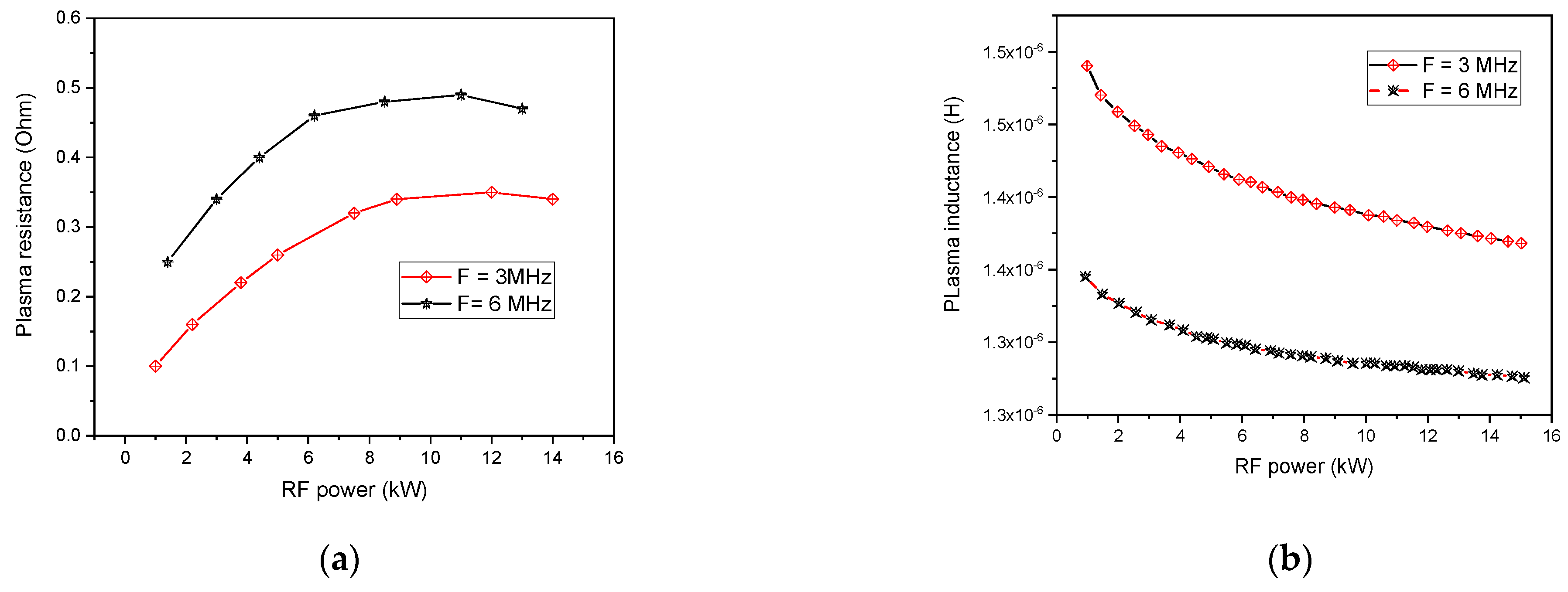

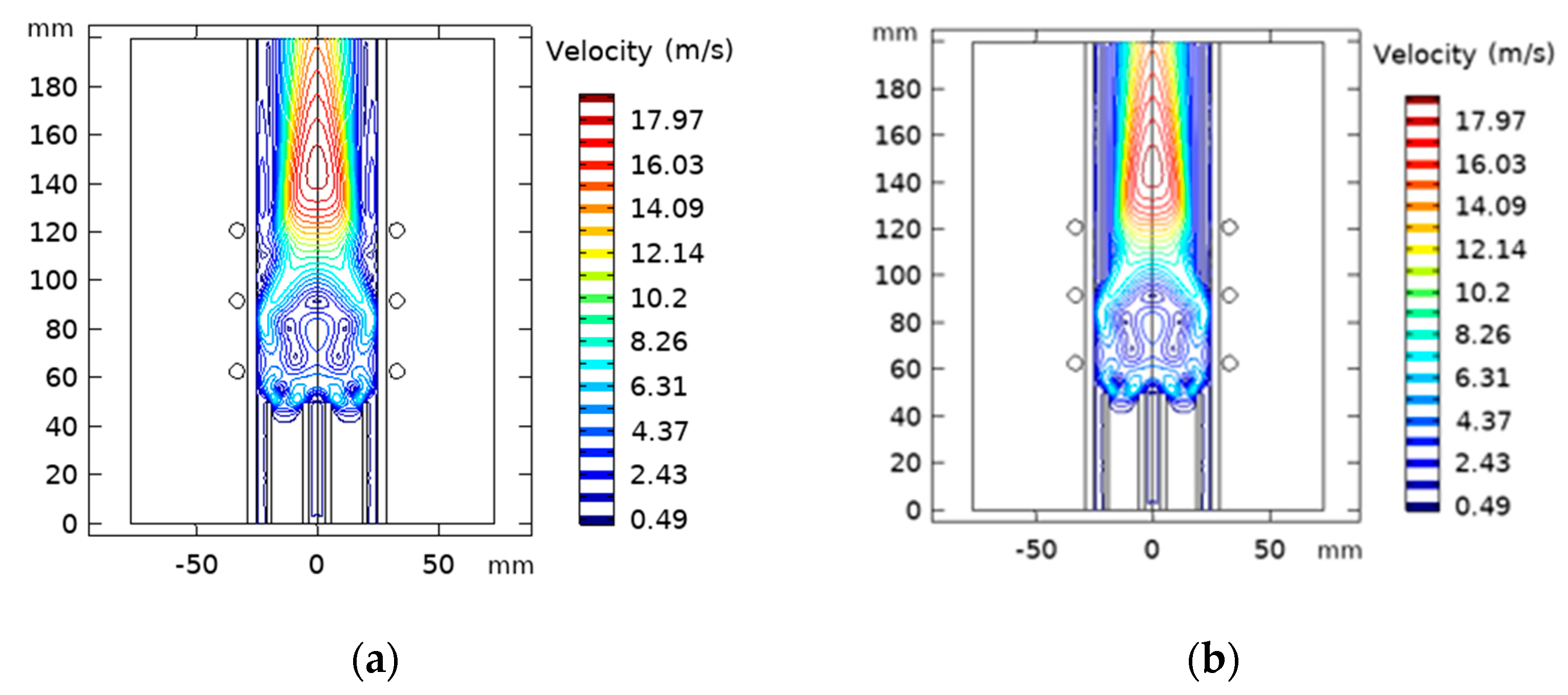
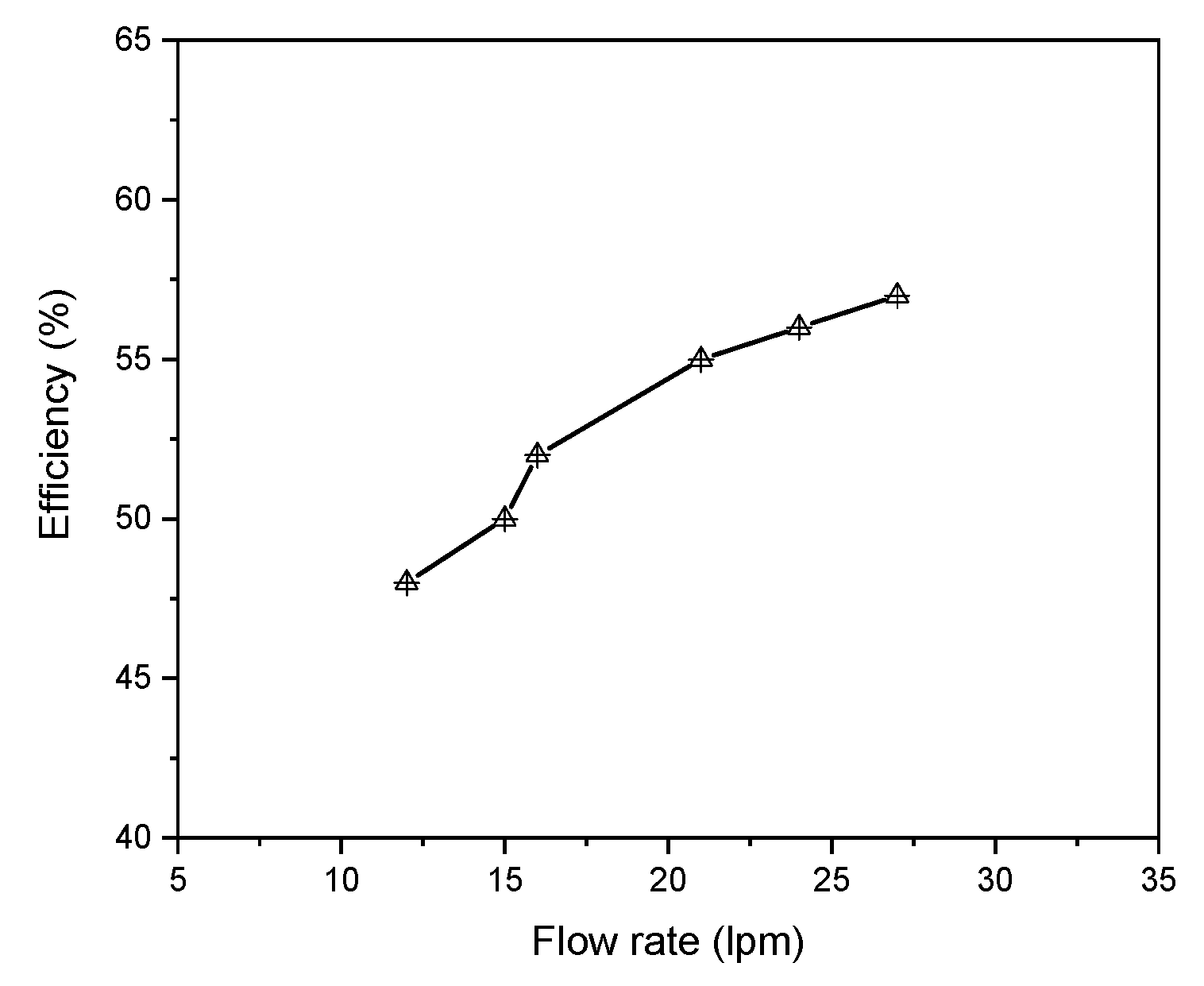

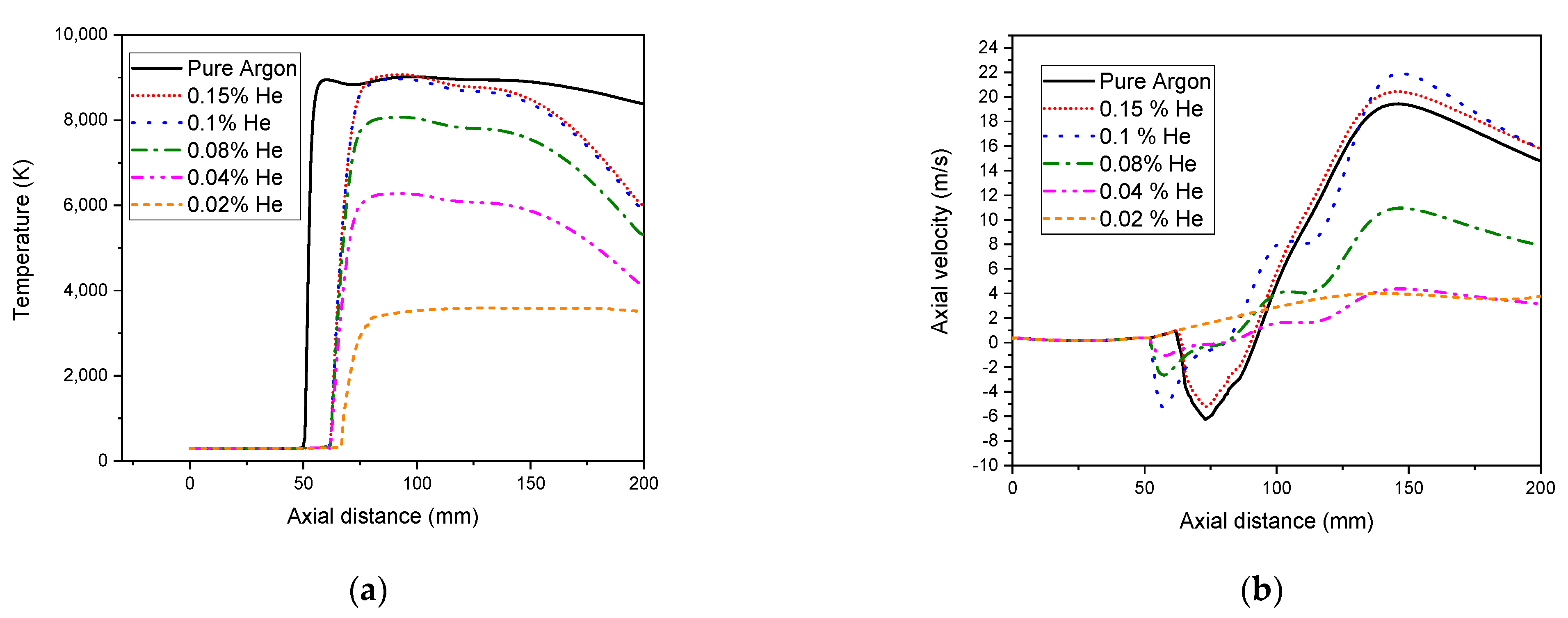



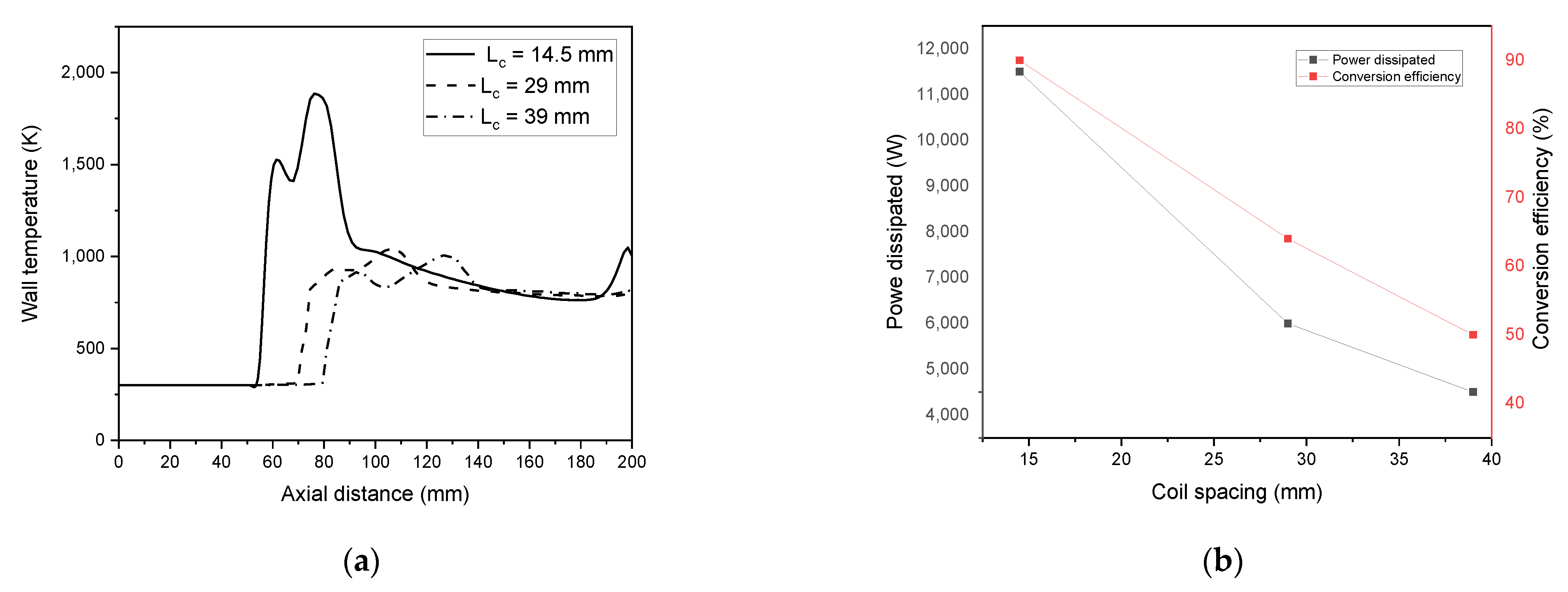


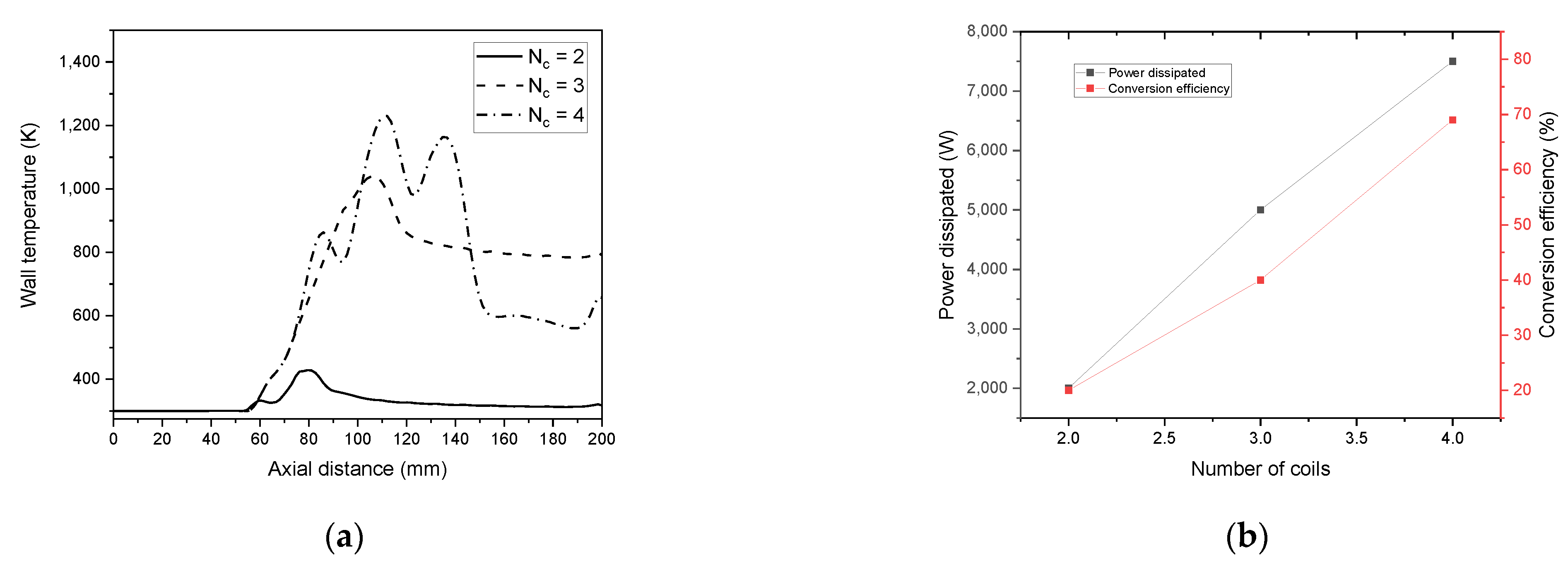
| Dimensions | Value |
|---|---|
| Nozzle radius r1 | 3.7 mm |
| Nozzle radius r2 | 18.8 mm |
| Inner torch wall radius rw | 25 mm |
| Thickness inner tube d | 2 mm |
| Radius to center coil rc | 33 mm |
| Axial position of lower coil z1 | 63 mm |
| Coil length zc | 58 mm |
| Reactor length z3 | 200 mm |
| Wall thickness δw | 3.5 mm |
| Voltage waveform | Sinusoidal |
| Gas | Argon |
| Coil turn number N | 3.0 turns |
| Ambient temperature T | 300.0 K |
| Coil excitation power P | 15.0 kW |
| Coil frequency f | 3 MHz |
| Operational pressure p | 1.0 atm |
| Injected flow rate Q1, Q2, Q3 | 1.0, 3.0, 21.0 lpm |
Publisher’s Note: MDPI stays neutral with regard to jurisdictional claims in published maps and institutional affiliations. |
© 2022 by the authors. Licensee MDPI, Basel, Switzerland. This article is an open access article distributed under the terms and conditions of the Creative Commons Attribution (CC BY) license (https://creativecommons.org/licenses/by/4.0/).
Share and Cite
Elaissi, S.; Trabelsi, A.B.G.; Alkallas, F.H.; Alrebdi, T.A.; Charrada, K. Energy Efficiency Enhancement of Inductively Coupled Plasma Torch: Computational Study. Materials 2022, 15, 5213. https://doi.org/10.3390/ma15155213
Elaissi S, Trabelsi ABG, Alkallas FH, Alrebdi TA, Charrada K. Energy Efficiency Enhancement of Inductively Coupled Plasma Torch: Computational Study. Materials. 2022; 15(15):5213. https://doi.org/10.3390/ma15155213
Chicago/Turabian StyleElaissi, Samira, Amira Ben Gouider Trabelsi, Fatemah H. Alkallas, Tahani A. Alrebdi, and Kamel Charrada. 2022. "Energy Efficiency Enhancement of Inductively Coupled Plasma Torch: Computational Study" Materials 15, no. 15: 5213. https://doi.org/10.3390/ma15155213
APA StyleElaissi, S., Trabelsi, A. B. G., Alkallas, F. H., Alrebdi, T. A., & Charrada, K. (2022). Energy Efficiency Enhancement of Inductively Coupled Plasma Torch: Computational Study. Materials, 15(15), 5213. https://doi.org/10.3390/ma15155213







